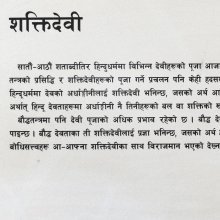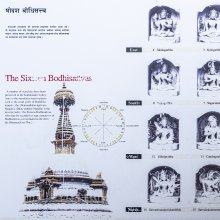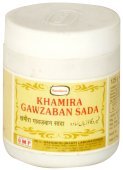Shata, Sata, Sāṭa, Sāta, Saṭa, Śaṭa, Śata, Sātā, Śaṭā, Śāta, Saṭā, Satā: 31 definitions
Introduction:
Shata means something in Buddhism, Pali, Hinduism, Sanskrit, Jainism, Prakrit, the history of ancient India, Marathi, Hindi, biology, Tamil. If you want to know the exact meaning, history, etymology or English translation of this term then check out the descriptions on this page. Add your comment or reference to a book if you want to contribute to this summary article.
The Sanskrit terms Śaṭa and Śata and Śaṭā and Śāta can be transliterated into English as Sata or Shata, using the IAST transliteration scheme (?).
Alternative spellings of this word include Saat.
Images (photo gallery)
(+5 more images available)
In Hinduism
Purana and Itihasa (epic history)
Source: archive.org: Puranic EncyclopediaSāta (सात).—A great yakṣa friend of Vaiśravaṇa. (See under Dīpakarṇi for the story about how Sāta became a cursed Yakṣa).
Source: Cologne Digital Sanskrit Dictionaries: The Purana Index1) Śaṭa (शट).—A Dānava.*
- * Brahmāṇḍa-purāṇa III. 6. 9.
2) Śata (शत).—A son of Jambha.*
- * Vāyu-purāṇa 67. 78.

The Purana (पुराण, purāṇas) refers to Sanskrit literature preserving ancient India’s vast cultural history, including historical legends, religious ceremonies, various arts and sciences. The eighteen mahapuranas total over 400,000 shlokas (metrical couplets) and date to at least several centuries BCE.
Kavya (poetry)
Source: Wisdom Library: KathāsaritsāgaraSāta (सात) is the name of a Yakṣa, who took the form of a lion, and got shot with an arrow by Dvīpikarṇi, according to the Kathāsaritsāgara chapter 6.
The Kathāsaritsāgara (‘ocean of streams of story’), mentioning Sāta, is a famous Sanskrit epic story revolving around prince Naravāhanadatta and his quest to become the emperor of the vidyādharas (celestial beings). The work is said to have been an adaptation of Guṇāḍhya’s Bṛhatkathā consisting of 100,000 verses, which in turn is part of a larger work containing 700,000 verses.

Kavya (काव्य, kavya) refers to Sanskrit poetry, a popular ancient Indian tradition of literature. There have been many Sanskrit poets over the ages, hailing from ancient India and beyond. This topic includes mahakavya, or ‘epic poetry’ and natya, or ‘dramatic poetry’.
Ayurveda (science of life)
Source: gurumukhi.ru: Ayurveda glossary of termsŚāta (शात):—[śātaḥ] Putrifaction

Āyurveda (आयुर्वेद, ayurveda) is a branch of Indian science dealing with medicine, herbalism, taxology, anatomy, surgery, alchemy and related topics. Traditional practice of Āyurveda in ancient India dates back to at least the first millenium BC. Literature is commonly written in Sanskrit using various poetic metres.
Jyotisha (astronomy and astrology)
Source: Wisdom Library: Brihat Samhita by VarahamihiraŚata (शत) or Śatavarṣa refers to a “period of 100 years”, according to the Bṛhatsaṃhitā (chapter 13), an encyclopedic Sanskrit work written by Varāhamihira mainly focusing on the science of ancient Indian astronomy astronomy (Jyotiṣa).—Accordingly, “During the reign of Yudhisthira, 2526 years before the commencement of Vikrama Śaka, the Seven Ṛṣis (saptarṣi) were at the constellation of Maghā (Regulus). The Ṛṣis take a period of 100 years [i.e., śata-varṣa—śataṃ śataṃ te caranti varṣāṇām] to go over each of the 27 asterisms. They rise in the north-east and are accompanied by the chaste Arundhatī—the consort of Vasiṣṭha. The eastern-most of the group is Bhagavān Marīci; the next to him is Vasiṣṭha; the next is Aṅgiras and the next two are—Atri and Pulastya. The next in order are the Ṛṣis—Pulaha and Kratu. The chaste Arundhatī closely attends her husband the sage Vasiṣṭha”.

Jyotisha (ज्योतिष, jyotiṣa or jyotish) refers to ‘astronomy’ or “Vedic astrology” and represents the fifth of the six Vedangas (additional sciences to be studied along with the Vedas). Jyotisha concerns itself with the study and prediction of the movements of celestial bodies, in order to calculate the auspicious time for rituals and ceremonies.
Ganitashastra (Mathematics and Algebra)
Source: archive.org: Hindu MathematicsŚata (शत) refers to “hundred” (100) in various lists of numeral denominations, according to gaṇita (“science of calculation”) and Gaṇita-śāstra, ancient Indian mathematics and astronomy.—We can definitely say that from the very earliest known times, ten has formed the basis of numeration in India. While the Greeks had no terminology for denominations above the myriad (104), and the Romans above the milk (103), the ancient Hindus dealt freely with no less than eighteen denominations [e.g., śata]. Cf. Yajurveda-saṃhitā (Vājasanyī) XVII.2; Taittirīya-saṃhitā IV.40.11, VII.2.20.1; Maitrāyaṇī-saṃhitā II.8.14; Kāṭhaka-saṃhitā XVII.10, XXXIX.6; Anuyogadvāra-sūtra 142; Āryabhaṭīya II.2; Triśatikā R.2-3; Gaṇitasārasaṃgraha I.63-68.

Ganitashastra (शिल्पशास्त्र, gaṇitaśāstra) refers to the ancient Indian science of mathematics, algebra, number theory, arithmetic, etc. Closely allied with astronomy, both were commonly taught and studied in universities, even since the 1st millennium BCE. Ganita-shastra also includes ritualistic math-books such as the Shulba-sutras.
In Buddhism
Theravada (major branch of Buddhism)
Source: Pali Kanon: Pali Proper NamesAn eminent Theri of Ceylon. Dpv.xviii.16.
Theravāda is a major branch of Buddhism having the the Pali canon (tipitaka) as their canonical literature, which includes the vinaya-pitaka (monastic rules), the sutta-pitaka (Buddhist sermons) and the abhidhamma-pitaka (philosophy and psychology).
Mahayana (major branch of Buddhism)
Source: academia.edu: A Study and Translation of the GaganagañjaparipṛcchāŚata (शत) refers to a “hundred” (e.g., a hundredfold merits), according to the Gaganagañjaparipṛcchā: the eighth chapter of the Mahāsaṃnipāta (a collection of Mahāyāna Buddhist Sūtras).—Accordingly, “[...] The Bodhisattva Gaganagañja then sustained the jewel-canopy of ten thousand yojanas high over the Lord’s lion throne in the sky, joined the palms of his hands, saluted, and praised the Lord with these suitable verses: ‘[...] (2) Victorious One (jīna) whose absolute body (dharmakāya) is the same as the manifested (prabhāvita) body, displayed his beautiful body (abhirūpa) as endowed with well-shaped forms (surūpa), having produced (prajanita) compassion (karuṇā) that brings benefits for living beings, reveals the supreme body which has the marks of hundredfold merits (śata-puṇya-lakṣaṇa). [...]’”.

Mahayana (महायान, mahāyāna) is a major branch of Buddhism focusing on the path of a Bodhisattva (spiritual aspirants/ enlightened beings). Extant literature is vast and primarely composed in the Sanskrit language. There are many sūtras of which some of the earliest are the various Prajñāpāramitā sūtras.
General definition (in Buddhism)
Source: Wisdom Library: Dharma-samgrahaSāta (सात, “pleasant”) refers to one of the “twenty form objects” (rūpa) as defined in the Dharma-saṃgraha (section 34). The Dharma-samgraha (Dharmasangraha) is an extensive glossary of Buddhist technical terms in Sanskrit (e.g., sāta). The work is attributed to Nagarjuna who lived around the 2nd century A.D.
Source: Wisdom Library: BuddhismŚata (शत, “hundred”) is the third of sixty digits (decimal place) in an special enumeration system mentioned by Vasubandhu in his Abhidharmakośa (“treasury of knowledge”). The explanations of the measure of years, eons, and so forth must be comprehended through calculation based on a numerical system. Enumeration begins from one and increases by a factor of ten for each shift in decimal place. The sixtieth number in this series is called “countless”.
Among these decimal positions (e.g., śata, “hundred”), the first nine positions from one to one hundred million are called ‘single set enumeration’. From a billion up to, but not including countless is “the enumeration of the great companion” and is called the ‘recurring enumeration’.
In Jainism
General definition (in Jainism)
Source: archive.org: TrisastisalakapurusacaritraSāta (सात) or Sātagaurava refers to “(the vanity of) pleasure”, according to chapter 1.1 [ādīśvara-caritra] of Hemacandra’s 11th century Triṣaṣṭiśalākāpuruṣacaritra: an ancient Sanskrit epic poem narrating the history and legends of sixty-three illustrious persons in Jainism.—Accordingly, in the sermon of Sūri Dharmaghoṣa:—“[...] the gift of supporting dharma (dharmopagrahadāna) is five-fold: purity of giver, receiver, gift, time, and thought. [... ] That gift would have purity of receiver, whose receiver is such a man [who is] lacking in three vanities (gaurava) [viz., sāta-gaurava], [...]”.—(Cf. Samavāyāṅgasūtra 3, p. 9a. Uttarādhyayana 31.4).
Source: The University of Sydney: A study of the Twelve Reflections1) Sāta (सात) refers to “pleasure”, according to the 11th century Jñānārṇava, a treatise on Jain Yoga in roughly 2200 Sanskrit verses composed by Śubhacandra.—Accordingly, “Look [here], for men, those material objects dear to the mind which were possessed of the character of pleasure (sukharūpa; var.: sāta-rūpa—“the character of pleasure”) before are now afflicted with the character of suffering”.
Synonyms: Sukha, Śarma.
2) Śata (शत) refers to a “hundred (counteractions)”, according to the Jñānārṇava.—Accordingly, “Where this wicked Yama is not stopped by the 30 [gods] even with a hundred counteractions (pratīkāra-śata), what should one say of [Yama being stopped] there by the insects of men? O fool, sentient beings, having begun from the womb, are continually led by [their own] action to Yama’s abode by means of uninterrupted journeys”.

Jainism is an Indian religion of Dharma whose doctrine revolves around harmlessness (ahimsa) towards every living being. The two major branches (Digambara and Svetambara) of Jainism stimulate self-control (or, shramana, ‘self-reliance’) and spiritual development through a path of peace for the soul to progess to the ultimate goal.
India history and geography
Source: Cologne Digital Sanskrit Dictionaries: Indian Epigraphical GlossaryŚata.—cf. ekādaśa-śata (ML), ‘one hundred and eleven’. Note: śata is defined in the “Indian epigraphical glossary” as it can be found on ancient inscriptions commonly written in Sanskrit, Prakrit or Dravidian languages.
--- OR ---
Sāta.—(EI 32), abbreviation of the name Śātavāhana or Śātakarṇi. Note: sāta is defined in the “Indian epigraphical glossary” as it can be found on ancient inscriptions commonly written in Sanskrit, Prakrit or Dravidian languages.

The history of India traces the identification of countries, villages, towns and other regions of India, as well as mythology, zoology, royal dynasties, rulers, tribes, local festivities and traditions and regional languages. Ancient India enjoyed religious freedom and encourages the path of Dharma, a concept common to Buddhism, Hinduism, and Jainism.
Biology (plants and animals)
Source: Google Books: CRC World Dictionary (Regional names)Sata in Indonesia is the name of a plant defined with Casearia borneensis in various botanical sources. This page contains potential references in Ayurveda, modern medicine, and other folk traditions or local practices.
Example references for further research on medicinal uses or toxicity (see latin names for full list):
· Journal of the Straits Branch of the Royal Asiatic Society (1922)
If you are looking for specific details regarding Sata, for example extract dosage, chemical composition, side effects, diet and recipes, pregnancy safety, health benefits, have a look at these references.

This sections includes definitions from the five kingdoms of living things: Animals, Plants, Fungi, Protists and Monera. It will include both the official binomial nomenclature (scientific names usually in Latin) as well as regional spellings and variants.
Languages of India and abroad
Pali-English dictionary
Source: BuddhaSasana: Concise Pali-English Dictionarysata : (adj.) mindful; conscious. (nt.), a hundred. || sāta (nt.), pleasure; comfort. (adj.) pleasant; agreeable.
Source: Sutta: The Pali Text Society's Pali-English DictionarySāṭa, (cp. Sk. śāṭa) a garment, cloth Th. 2, 245; sāṭi (f.) the same S. I, 115; Dh. 394; J. I, 230 (udaka° bathing mantle), 481. (Page 702)
— or —
Sāta, (adj.) (cp. *Sk. śāta) pleasant, agreeable It. 114; Nett 27. Often combined with piya, e.g. It. 114; Vbh. 103; DA. I, 311.—Opp. kaṭuka.—sāta (nt.) pleasure, joy M. I, 508; A. I, 81 sq.; S. II, 220; J. I, 410; Dh. 341 (°sita= sāta-nissita DhA. IV, 49); Sn. 867 sq.; Nd1 30 (three, of bhava); Pv. II, 113; IV, 54 (+sukha); Dhs. 3. asāta disagreeable, unpleasant Dhs. 1343; J. I, 410; J. I, 288; II, 105; Sn. 867 sq.; sātabhakkha Pug. 55, read haṭabhakkha. —odaka with pleasant water D. II, 129; M. I, 76; Vin. III, 108. —kumbha gold VvA. 13. See also v. l. under hāṭaka. —putta a noble son J. VI, 238 (=amacca-putta C.). (Page 702)
— or —
Saṭa, (most likely=Sk. śada (fall), fr. śad to fall; Kern Toev. s. v. equals it to Sk. sūta (or sṛta) of sṛ (or su) to run (to impel), as in ussaṭa and visaṭa. The Dhtm (789) gives a root saṭ in meaning of “visaraṇa, ” i.e. profusion, diffusion (cp. visaṭa)) a fall, a heap of things fallen; only in cpd. paṇṇa° a heap of fallen leaves M. I, 21 (=paṇṇa-kacavara MA. I, 120); J. II, 271. (Page 671)
— or —
1) Sata, 2 (pp. of sarati, of smṛ, cp. BSk. smṛta AvŚ I. 228; II, 197) remembering, mindful, conscious D. I, 37; II, 94; III, 49, 107, 222, 269; M. I, 520 (su-ssata & dus-sata); S. IV, 211; A. III, 169 (+sampajāna), 325; IV, 311; Sn. 741; Dhs. 163; DA. I, 211.—satokārin cultivator of sati Ps. I, 175. (Page 672)
2) Sata, 1 (num. card.) (Vedic śataṃ; cp. Av. sat∂m, Gr. e(-katόn, Lat. centum; Goth. hund=hundred; Idg. *kmtóm fr. dkm̊tóm (=decem), thus ultimately the same as daśa, i.e. decad (of tens)) a hundred, used as nt. (collect.), either —° or as apposition, viz. gāma-sataṃ a hundred (ship of) villages DhA. I, 180; jaṭila-satāni 100 ascetics Vin. I, 24; jāti° D. I, 13; or gāthā sataṃ 100 stanzas Dh. 102. -Often in sense of “many” or “innumerable, ” e.g. °kaku, °raṃsi, etc.; cp. °satāni bahūni J. IV, 310, 311.

Pali is the language of the Tipiṭaka, which is the sacred canon of Theravāda Buddhism and contains much of the Buddha’s speech. Closeley related to Sanskrit, both languages are used interchangeably between religions.
Marathi-English dictionary
Source: DDSA: The Molesworth Marathi and English Dictionary1) Śata (शत).—a (S) A hundred. śataṃ tatra pañcōttara śataṃ Where we are spending or giving a hundred what matters five over?
2) śāṭa (शाट).—Misspelled for chāṭa &c.
3) saṭa (सट).—f (ṣaṣṭhī S) The sixth day of either half-month. 2 A female divinity, a form of Durga. 3 Worship of Durga. See under saṭhī.
4) sata (सत).—n Popular form of satva, but used esp. in the sense Cream, pith, marrow, essence, substance; and in the sense Virtue, vigor, spirit, potency, strength. Also for the phrases sata ghēṇēṃ, sata sōḍaṇēṃ, satāsa jāgaṇēṃ &c. see under satva.
sata (सत).—ind (sāta) The term used in multiplying by 7 any of the numbers above unity. Ex. tīna satēṃ ēkavīsa.
5) sāṭa (साट).—m A frame composed of slit bamboos or slender sticks laid along and fastened together; forming the deck or flooring of boats and small vessels: also the lathing or similar work over the rafters of a roof: also the floor of a loft &c.
sāṭa (साट).—n A cake formed of the pulp (of the jack, mango &c.) well mashed and blended, and rolled out.
6) sāṭā (साटा).—m (By mispronunciation of chāṭā) A drop cast in sprinkling.
sāṭā (साटा) [or ट्या, ṭyā].—m A frame &c. See sāṭhā or ṭhyā.
sāṭā (साटा).—m (sāṭaṇēṃ To heap or store.) Stuffing material (of gūḷapāpaḍī, sāraṇa, khōbarēṃ, crumbled plantains &c.) for puffs and cakes. Applied also to the flour, or butter, ghee, or oil which is sprinkled or smeared between the layers of pastry. v dē, lāva, bhara, kara.
7) sāta (सात).—a (sapta S) Seven. Used, as are the words for seven in other languages, to express Completeness or largeness of number. See in order sāta tāḍa uñca, sāta labāḍa, sāta sāyāsa, sātā paḍadyānta basaṇēṃ, sātavyā majalyāvara or sātavyā tāḷīṃ basaṇēṃ, sātāḷaśī &c.
sāta (सात).—f (Better sātha) Company or companionship: also a companion.
sāta (सात).—f (satata Constant or continual.) A course or run (esp. of epidemic disease--small pox, measles, influenza, fever &c.); and, freely, of any matter of one kind or character; as bhākarīcī or bhātācī sāta (bhōjanāsa); mulāñcī or mulīñcī sāta (bāyakōsa).
sāta (सात) [or सांत, sānta].—f A particular fish.
Source: DDSA: The Aryabhusan school dictionary, Marathi-English1) Śata (शत).—a A hundred. śataka n A century or a cento.
2) saṭa (सट).—f (A corrupt form of ṣaṣṭhī.) Name of durgā. Worship of durgā.
3) sāṭa (साट).—, m A bamboo frame. n A pulp-cake, (of the jack, mango &c.).
4) sāṭā (साटा).—m A drop cast in sprinkling. A frame. Stuffing material for cakes.
5) sāta (सात).—a Seven. f Company; a course or run.
Marathi is an Indo-European language having over 70 million native speakers people in (predominantly) Maharashtra India. Marathi, like many other Indo-Aryan languages, evolved from early forms of Prakrit, which itself is a subset of Sanskrit, one of the most ancient languages of the world.
Sanskrit dictionary
Source: DDSA: The practical Sanskrit-English dictionaryŚata (शत).—
1) A hundred; निःस्वो वष्टि शतम् (niḥsvo vaṣṭi śatam) Śānti.2.6; शतमेकोऽपि संधत्ते प्राकारस्थो धनुर्धरः (śatameko'pi saṃdhatte prākārastho dhanurdharaḥ) Pañcatantra (Bombay) 1.229; (śata is used in the singular with a plural noun of any gender; śataṃ narāḥ; śataṃ gāvaḥ; or śataṃ gṛhāṇi, in which case it is treated as a numeral adjective; but sometimes in dual and plural also; dve śate, daśa śatāni &c. It is also used with a noun in the genitive; gavāṃ śatam, varṣāṇāṃ śatam 'a century of cows, years' &c. At the end of comp., it may remain unchanged; bhava bhartā śaracchatam or may be changed into śatī; as in āryāsaptaśatī a work of Govardhanāchārya.).
2) Any large number; as in शतपत्र (śatapatra) q. v.
--- OR ---
Śaṭa (शट).—a. Sour, acid, astringent.
--- OR ---
Śaṭā (शटा).—The matted hair of an ascetic; cf. जटा, सिंहकेशर (jaṭā, siṃhakeśara).
--- OR ---
Śāṭa (शाट).—
1) A garment, cloth; यस्मिननोतमिदं प्रोतं विश्वं शाटीव तन्तुषु (yasminanotamidaṃ protaṃ viśvaṃ śāṭīva tantuṣu); Bhāgavata 9.9.7.
2) A petticoat.
3) A particular female garment; स्फुरत् काञ्ची शाटी पृथुकटितटे हाटक- मयी (sphurat kāñcī śāṭī pṛthukaṭitaṭe hāṭaka- mayī) Ā. L.3.
Derivable forms: śāṭaḥ (शाटः).
See also (synonyms): śāṭī.
--- OR ---
Śāta (शात).—p. p. [śo-kta]
1) Sharpened, whetted; हास्यः पश्यन्नपि रिपुशिरः शाणशातं कुठारम् (hāsyaḥ paśyannapi ripuśiraḥ śāṇaśātaṃ kuṭhāram) Mv.3.28; sharp; रामे शातकुठारभासुरकरे क्षत्रद्रुमोच्छेदिनि (rāme śātakuṭhārabhāsurakare kṣatradrumocchedini) Ve.6.12.
2) Thin, slender; शय्यागतेन रामेण माता शातोदरी बभौ (śayyāgatena rāmeṇa mātā śātodarī babhau) R.1.69.
3) Weak, feeble.
4) Beautiful, handsome.
5) Cut down.
6) Happy, thriving.
-taḥ The Dhattūra plant.
-tam Happiness, pleasure, delight; मानिनीजनजनितशातम् (māninījanajanitaśātam) Gīt. 1.
--- OR ---
Saṭa (सट) or Saṭā (सटा).—
1) An ascetic's matted hair.
2) The mane (of a lion); केनानेकदानवासितसठः सिंहोऽर्पितः पञ्जरे (kenānekadānavāsitasaṭhaḥ siṃho'rpitaḥ pañjare) Mu.7.6; Śiśupālavadha 1.47.
3) Bristles of a boar; विध्यन्तमुद्धृत- सटाः प्रतिहन्तुमीषु (vidhyantamuddhṛta- saṭāḥ pratihantumīṣu) R.9.6.
4) A braid of hair.
5) A crest.
6) (Fig.) Lustre, light; जटां तडिद्वह्निसटोग्ररोचिषम् (jaṭāṃ taḍidvahnisaṭograrociṣam) Bhāgavata 4.5.2.
7) A multitude, number.
Derivable forms: saṭam (सटम्).
--- OR ---
Sāta (सात).—p. p.
1) Given.
2) Destroyed.
-tam Pleasure, delight.
Source: Cologne Digital Sanskrit Dictionaries: Edgerton Buddhist Hybrid Sanskrit DictionaryŚaṭa (शट).—(°-) (?) (perhaps to AMg. saḍaṇa, nt., decaying, saḍiya, rotten; compare Nepali sarnu, to rot, putrefy, decay; fall to pieces; and many New Indic cognates, Turner, Nepalese Dict.; or, possibly, related to Sanskrit chaṭā, lump; compare Deśīnāmamālā 3.33 chaṃṭo = jala-chaṭā, drop of water?), in śaṭa-(or chaṭa-) siṅghāṇa, foul (or dropping? or, consisting of a lump ?) mucus: (Ārya-)Mañjuśrīmūlakalpa 112.24 (verse) (dūrād āvasathād gatvā…) visṛjec chaṭa-siṅghāṇaṃ mūtraprasravaṇaṃ tathā. Note that chaṭa- is an equally possible assumption for the form intended.
--- OR ---
Śāta (शात).—or sāta, adj., or sometimes subst. nt. (= Pali sāta; Sanskrit Lex., and once in [compound] ati-śāta, [Boehtlingk and Roth]; compare sātīyati), pleasant, agreeable, or as n. pleasantness, pleasure (opp. a-, less often vi-śāta): Mahāvyutpatti 1882 śātam = Tibetan phya le ba (fine, smooth, refined, pleasant, [Tibetan-English Dictionary]) or mñam pa (level); sātaṃ Dharmasaṃgraha 34; sukha-sāta-saṃgatā Mahāvastu i.97.3, 5; sāta-sukha-sahagatam Bodhisattvabhūmi 208.26; priyarūpa-śātarūpa- Śikṣāsamuccaya 223.9; Aṣṭasāhasrikā-prajñāpāramitā 333.5 (°sāta°); sāta-sita (= Pali id., same verse, Dhammapada (Pali) 341) bound by pleasures Udānavarga iii.5; in Mahāvastu ii.480.6 Senart by em. tasyā ahaṃ na sātā (mss. mātā) bhaviṣyāmi, towards her I shall not be agreeable, i.e. I shall be offended at her; but perhaps the reading of mss. may be kept; Princess Sudarśanā speaks, referring to her attendants: I shall not be a mother to her, i.e. I shall not cherish her.
--- OR ---
Sāta (सात).—see śāta.
Source: Cologne Digital Sanskrit Dictionaries: Shabda-Sagara Sanskrit-English DictionaryŚaṭa (शट).—mfn.
(-ṭaḥ-ṭā-ṭaṃ) Sour, astringent, acid. E. śaṭ to pain, aff. ac .
--- OR ---
Śaṭā (शटा).—f.
(-ṭā) An ascetic’s clotted hair. 2. A mane: see saṭā .
--- OR ---
Śata (शत).—n.
(-taṃ) 1. A hundred. 2. Any large number. E. śo-ḍatac .
--- OR ---
Śāṭa (शाट).—m.
(-ṭaḥ) A garment in general. E. śaṭ-ghañ .
--- OR ---
Śāta (शात).—mfn.
(-taḥ-tā-taṃ) 1. Happy, well, prosperous. 2. Feeble, thin. 3. Sharpened, whetted, sharp. 4. Handsome, bright. n.
(-taṃ) Joy, pleasure, happiness. E. śo to reduce or diminish, aff. kta .
--- OR ---
Saṭa (सट).—mfn. Subst.
(-ṭaḥ-ṭā-ṭaṃ) An ascetic’s clotted hair, or the hair collected into a loose braid and twisted forwards upon the forehead. 2. A mane. 3. A crest. 4. Bristles of a boar. E. ṣaṭ to be a part of, and ac aff.
--- OR ---
Sāta (सात).—mfn.
(-taḥ-tā-taṃ) 1. Given. 2. Destroyed. n.
(-taṃ) Pleasure, delight. E. ṣaṇ to give, or ṣo to destroy, aff. kta, form irr.; see sita; or more properly sāt to give pleasure, aff. ac .
Source: Cologne Digital Sanskrit Dictionaries: Benfey Sanskrit-English DictionaryŚaṭā (शटा).—see saṭā.
--- OR ---
Śata (शत).—numeral, n. (also m., [Nala] 15, 6, śataṃ śatās, ten thousand), A hundred,
--- OR ---
Śāṭa (शाट).—m., and f. ṭī, and śāṭaka śāṭaka, m. and n. 1. A petticoat, [Pañcatantra] i. [distich] 160 (ṭaka); [Rāmāyaṇa] 2, 32, 21 (ṭī); a gown, [Mṛcchakaṭikā, (ed. Stenzler.)] 49, 11. 2. (ṭī), Cloth, [Bhāgavata-Purāṇa, (ed. Burnouf.)] 9, 9, 7. 3. (ṭa), A garment, Böhtl. Ind. Spr. 1210.
--- OR ---
Saṭa (सट).— (cf. jaṭa), m., f. ṭā (also śaṭā śaṭā, ) [Padma-Purāṇa, (ed. Wollheim.)] 16, 97), and n. 1. An ascetic’s clotted hair, [Bhāgavata-Purāṇa, (ed. Burnouf.)] 7, 8, 32 (ṭā). 2. A braid of hair, [Draupadīpramātha] 9, 9 (ṭā); a mane, [Śiśupālavadha] 1, 47; bristles (of a boar), [Raghuvaṃśa, (ed. Stenzler.)] 9, 60. 3. A crest.
Source: Cologne Digital Sanskrit Dictionaries: Cappeller Sanskrit-English DictionaryŚata (शत).—[neuter] ([masculine]) hundred, also as expression of a large or infinite number (adj. [feminine] —°).
--- OR ---
Śāṭa (शाट).—[masculine] ī [feminine], śāṭaka [masculine] [neuter] cloth, scarf.
--- OR ---
Śāta (शात).—1. [adjective] sharpened, whetted; thin, slender.
--- OR ---
Śāta (शात).—2. [masculine] the falling out (of hair, nails etc.).
--- OR ---
Saṭā (सटा).—[feminine] braid of hair, mane, the bristles of a boar; multitude, abundance; light, splendour.
--- OR ---
Sata (सत).—[masculine] [neuter] a cert. vessel or dish.
--- OR ---
Sāta (सात).—[adjective] gained, acquired; [masculine] [Name] of a Yaksha.
Source: Cologne Digital Sanskrit Dictionaries: Monier-Williams Sanskrit-English Dictionary1) Śaṭa (शट):—[from śaṭ] mfn. sour, astringent, acid, [cf. Lexicographers, esp. such as amarasiṃha, halāyudha, hemacandra, etc.]
2) [v.s. ...] m. Name of a man [gana] gargādi
3) [v.s. ...] of a son of Vasu-deva, [Harivaṃśa] ([probably] [wrong reading] for śaṭha)
4) [v.s. ...] of a country [gana] śaṇḍikādi.
5) Śaṭā (शटा):—f. (= saṭā, jaṭā) an ascetic’s clotted hair, [Horace H. Wilson]
6) Śata (शत):—n. (rarely m.; ifc. f(ī). ) a hundred (used with other numerals thus, ekādhikaṃ śatam, or eka-ś, a h° + one, 101 viṃśaty-adhikaṃ śatam or viṃśaṃ ś, a h° + twenty, 120; śate or dve śate or dvi-śatam or śata-dvayam, 200; trīṇi śatāni or tri-śatāni or śata-trayam, 300; ṣaṭ-śatam, 600; or the [compound] becomes an ordinal e.g. dvi-śata, the 200th; dvikaṃ, trikaṃ śatam = 2, 3 per cent; śatātpara, ‘beyond a h°, exceeding 100’; the counted object is added either in the [genitive case], or in the same case as śata, or [in the beginning of a compound] e.g. śatam pitaraḥ or, śatam pitṝṇām or pitṛ-śatam ‘a h° ancestors’; sometimes also ifc. See [compound] below; rarely śatam is used as an indecl. with an [instrumental case] e.g. śataṃ rathebhiḥ, ‘with a h° chariots’ [Ṛg-veda i, 48, 7]; rarely occurs a masc. form in [plural] e.g. pañca-śatā, rathān, [Mahābhārata iv, 1057]; and śata n. rarely in [compound] of the following kind, catur-varṣa-śatam or tāni, ‘400 years’), [Ṛg-veda]; etc.
7) any very large number (in [compound] as śata-pattra etc. below).
8) cf. [Greek] ἑ-κατόν ‘one’ hundred; [Latin] centum; [Lithuanian] szmtas; Got. (twa) hunda; [German] hund-ert; [English] hund-red.
9) Śatā (शता):—[from śata] in [compound] for śata.
10) Śāṭa (शाट):—m. ([from] √śaṭ?) a strip of cloth, a kind of skirt or petticoat, a [particular] sort of garment or gown, [Vasiṣṭha; Cāṇakya]
11) Śāta (शात):—1. śāta mfn. ([from] √śo; cf. śita) sharpened, whetted, sharp, [Kathāsaritsāgara; Rājataraṅgiṇī]
12) thin, feeble, slender, emaciated, [Harivaṃśa; Kāvya literature; Varāha-mihira’s Bṛhat-saṃhitā]
13) n. the thorn-apple, [Monier-Williams’ Sanskrit-English Dictionary]
14) 2. śāta m. ([from] √2. śad) falling out or decaying (of nails, hair etc.), [Suśruta]
15) 3. śāta n. joy, pleasure, happiness, [cf. Lexicographers, esp. such as amarasiṃha, halāyudha, hemacandra, etc.]
16) mfn. handsome, bright, happy, [Horace H. Wilson]
17) 4. śāta Vṛddhi form of śata, in [compound]
18) [from śo] a mfn. See 1. śāta, p. 1063, col. 3.
19) Saṭa (सट):—m. n. = next, [cf. Lexicographers, esp. such as amarasiṃha, halāyudha, hemacandra, etc.]
20) a person whose father is a Brāhman and whose mother is a Bhāṭi, [cf. Lexicographers, esp. such as amarasiṃha, halāyudha, hemacandra, etc.]
21) Saṭā (सटा):—[from saṭa] f. (cf. śaṭā, chaṭā and jaṭā) an ascetic’s matted or clotted hair, a braid of hair (in general), [Mahābhārata]
22) [v.s. ...] the mane (of a lion or horse) or the bristles (of a boar), [Mahābhārata; Kāvya literature] etc.
23) [v.s. ...] a crest (= śikhā), [cf. Lexicographers, esp. such as amarasiṃha, halāyudha, hemacandra, etc.]
24) [v.s. ...] a multitude, number, [Varāha-mihira’s Bṛhat-saṃhitā]
25) [v.s. ...] light, lustre, [Bhāgavata-purāṇa]
26) Sata (सत):—1. sata m. n. a kind of sacrificial vessel, [Vājasaneyi-saṃhitā; Śatapatha-brāhmaṇa; Kātyāyana-śrauta-sūtra]
27) 2. sata See dvayaand dve-s.
28) Sāta (सात):—[from sā] 1. sāta mfn. gained, obtained, [Ṛg-veda; Brāhmaṇa]
29) [v.s. ...] granted, given, bestowed, [Ṛg-veda]
30) [v.s. ...] n. a gift, wealth, riches, [ib.]
31) [from sā] 2. sāta mfn. (for 3. See p. 1200, col. 1) ended, destroyed, [Horace H. Wilson]
32) [from sāt] 3. sāta n. (for 1. and 2. See p. 1196, col. 3) pleasure, delight, [cf. Lexicographers, esp. such as amarasiṃha, halāyudha, hemacandra, etc.]
Source: Cologne Digital Sanskrit Dictionaries: Yates Sanskrit-English Dictionary1) Śaṭa (शट):—[(ṭaḥ-ṭā-ṭaṃ) a.] Sour, acid.
2) Śaṭā (शटा):—(ṭā) 1. f. An ascetic’s clotted hair.
3) Śata (शत):—(taṃ) 1. n. A hundred.
4) Śāta (शात):—(taṃ) 1. n. Joy, pleasure. a. Happy; feeble; sharpened.
5) Saṭa (सट):—(ka) saṭayati 10. a. To manifest.
6) [(ṭaḥ-ṭā-ṭaṃ)] 1. m. f. n. An ascetic’s clotted hair; a mane; a crest.
7) Sāta (सात):—(taṃ) 1. n. Pleasure, delight. a. Given; destroyed.
Source: DDSA: Paia-sadda-mahannavo; a comprehensive Prakrit Hindi dictionary (S)Śāṭa (शाट) in the Sanskrit language is related to the Prakrit words: Jhoḍa, Saḍhā, Saya, Sāḍa, Sāta, Sāya.
[Sanskrit to German]
Sanskrit, also spelled संस्कृतम् (saṃskṛtam), is an ancient language of India commonly seen as the grandmother of the Indo-European language family (even English!). Closely allied with Prakrit and Pali, Sanskrit is more exhaustive in both grammar and terms and has the most extensive collection of literature in the world, greatly surpassing its sister-languages Greek and Latin.
Hindi dictionary
Source: DDSA: A practical Hindi-English dictionary1) Śata (शत) [Also spelled shat]:—(nm) one hundred; ~[dhā] in a hundred ways; ~[patra] the lotus (flower); —[pratiśata] cent per cent; ~[vārṣikī] centenary; •[samāroha] centenary celebration.
2) Saṭā (सटा):—(nf) mane; thickened locks of hair; (a) see [saṭanā].
3) Sata (सत) [Also spelled sat]:—(nm) essence, juice; strength, vitality; truth, truthfulness; an allomorph of [sāta] used as the first member in certain compound words; ~[gunā] seven times; ~[guru] true/good preceptor; God; ~[juga] one and the first of the four yugas (the other being [dvāpara, tretā] and [kali]) of the universe according to Indian mythology. The [satayuga] is said to be the best or golden period/age of creation; ~[yugī] belonging to the ~[yuga; ~najā] a mixture of seven corns; ~[raṃga/raṃgā] seven-coloured; multicoloured; ~[māsā] of seven months; a ceremony performed about the seventh month of pregnancy; (a child) born in the seventh month of pregnancy; ~[laḍā] seven-stringed (necklace, etc.); ~[vaṃtī] (a) chaste (woman); ~[vāṃsā] see ~[māsā; ~saī] a collection of seven hundred (and odd) couplets (generally [dohā] and [soraṭhā]); see [sat; —ḍigā jahāna ḍigā] when character is lost all is lost; —[para (jame) rahanā] to hold on to the righteous path; to maintain one’s chastity.
4) Sāta (सात) [Also spelled saat]:—(a) seven; (nm) the number seven; —[janama meṃ bhī nahīṃ] never, never—in this or even afterlife; —[ghara bhīkha māṃganā] to go abegging; -[pāṃca] guiles, cunningness; •[na jānanā] to be guileless, to be extremely credulous; -[pāṃca lagānā] to higgle, to raise numerous objections; —[paradoṃ meṃ rakhanā] to keep away from all eyes, to keep well in-doors; —[samuṃdara pāra] across the seven seas, very very far.
...
Prakrit-English dictionary
Source: DDSA: Paia-sadda-mahannavo; a comprehensive Prakrit Hindi dictionarySāta (सात) in the Prakrit language is related to the Sanskrit word: Sāta.
Prakrit is an ancient language closely associated with both Pali and Sanskrit. Jain literature is often composed in this language or sub-dialects, such as the Agamas and their commentaries which are written in Ardhamagadhi and Maharashtri Prakrit. The earliest extant texts can be dated to as early as the 4th century BCE although core portions might be older.
Kannada-English dictionary
Source: Alar: Kannada-English corpusŚata (ಶತ):—
1) [adjective] amounting to one hundred; hundred.
2) [adjective] greater in number; more.
--- OR ---
Śata (ಶತ):—[noun] the cardinal number one hundred; 100.
--- OR ---
Śāṭa (ಶಾಟ):—
1) [noun] a cloth (in gen.).
2) [noun] a clean, washed cloth.
3) [noun] an underskirt, often trimmed and hemmed, worn by women and girls.
--- OR ---
Śāṭa (ಶಾಟ):—[noun] the hair at the lower part of the abdomen surrounding the external genitals; pubes.
--- OR ---
Śāta (ಶಾತ):—
1) [adjective] sharp or sharpened; whetted; keen.
2) [adjective] not thick; thin.
3) [adjective] having little fat or flesh; lean.
--- OR ---
Śāta (ಶಾತ):—
1) [noun] a sharp-endged blade or weapon.
2) [noun] anything that is very thin.
3) [noun] lack of physical strength; weakness.
4) [noun] joy; pleasure.
5) [noun] the quality of being beautiful, charming or comley.
6) [noun] the plant Datura stramonium of Solanaceae family.
--- OR ---
Saṭa (ಸಟ):—
1) [noun] the long hair growing from the top or sides of the neck of certain animals, as the horse or lion; the mane.
2) [noun] long intertwined or matted hair.
--- OR ---
Saṭa (ಸಟ):—[noun] anything that is carried; a load; a burden.
--- OR ---
Sata (ಸತ):—[noun] that which is eternal.
--- OR ---
Sata (ಸತ):—
1) [adjective] (correctly, ಸತ [sata]) amounting to one hundred; hundred.
2) [adjective] greater in number; more.
--- OR ---
Sata (ಸತ):—[noun] (correctly, ಶತ [shata]) the cardinal number one hundred; 100.
--- OR ---
Sata (ಸತ):—[noun] a place or region belonging to or being under the jurisdiction of oneself.
--- OR ---
Sata (ಸತ):—
1) [noun] the act or an instance of losing colour, brilliance, freshness or strength; a withering.
2) [noun] a wound; an injury.
3) [noun] ಸತವಾಗು [satavagu] satavāgu to lose colour, brilliance, freshness or strength; to wither; to wane; to fade.
Kannada is a Dravidian language (as opposed to the Indo-European language family) mainly spoken in the southwestern region of India.
Tamil dictionary
Source: DDSA: University of Madras: Tamil LexiconSatā (ஸதா) adverb < sadā. Always. See சதா². [satha².]
--- OR ---
Sātā (ஸாதா) adjectival < Urdu sādā. See சாதா. [satha.]
Tamil is an ancient language of India from the Dravidian family spoken by roughly 250 million people mainly in southern India and Sri Lanka.
See also (Relevant definitions)
Starts with (+628): Catakopan, Satada, Satadha, Satagiri, Sataka, Satakam, Satakumbha, Satala, Satali, Satamuli, Satanjaya, Satapadi, Satapaka, Satapata, Sataranji, Satarasa, Satari, Satarka, Satasala, Satavahana.
Ends with (+326): Abdashata, Abhisata, Abhutalasparshata, Adakshata, Adhyakshata, Adhyardhashata, Adoshata, Agnikrishata, Akankshata, Akshata, Alakshata, Amishata, Anavakashata, Animeshata, Animishata, Anishata, Antarayashata, Apadoshata, Apakshata, Aparikshata.
Full-text (+1395): Shada, Satas, Satanka, Satakumbha, Sataka, Shatabhiru, Shatah, Shatasahasra, Shatananda, Shatabhisha, Saptashata, Satomukha, Satapatala, Shadha, Shatapathika, Satahpankti, Ardhashata, Satarasa, Sathah, Shatasahasrashas.
Relevant text
Search found 159 books and stories containing Shata, Sata, Sāṭa, Sāta, Saṭa, Śaṭa, Śata, Sātā, Śaṭā, Śāta, Saṭā, Satā, Śāṭa, Sāṭā, Śatā, Satha, Saathaa, Sada, Sadha, Sathaa, Saata; (plurals include: Shatas, Satas, Sāṭas, Sātas, Saṭas, Śaṭas, Śatas, Sātās, Śaṭās, Śātas, Saṭās, Satās, Śāṭas, Sāṭās, Śatās, Sathas, Saathaas, Sadas, Sadhas, Sathaas, Saatas). You can also click to the full overview containing English textual excerpts. Below are direct links for the most relevant articles:
Sahitya-kaumudi by Baladeva Vidyabhushana (by Gaurapada Dāsa)
Text 7.25 < [Chapter 7 - Literary Faults]
Text 10.108 < [Chapter 10 - Ornaments of Meaning]
Text 9.43 [necklace diagram] < [Chapter 9 - Ornaments of Sound]
Rig Veda (translation and commentary) (by H. H. Wilson)
Amaravati Art in the Context of Andhra Archaeology (by Sreyashi Ray chowdhuri)
The rule of the Sadas < [Chapter 4 - Survival of Amarāvatī in the Context of Andhra Art]
Lower Kṛṣṇā Valley (12): Rāmatīrtham < [Chapter 2 - Amarāvatī and other Archaeological Sites of Ancient Andhra Pradesh]
Epigraphs from Amarāvatī (e) Administrative and Bureaucratic < [Chapter 4 - Survival of Amarāvatī in the Context of Andhra Art]
Garga Samhita (English) (by Danavir Goswami)
Verse 6.19.1 < [Chapter 19 - In the First Fortress of Dvārakā, the Glories of Līlā-sarovara, etc.]
Verses 2.12.13-15 < [Chapter 12 - Subduing Kāliya and Drinking the Forest Fire]
Verse 6.9.27 < [Chapter 9 - The Arrival of Śrī Dvārakā]
Dhammapada (Illustrated) (by Ven. Weagoda Sarada Maha Thero)
Verse 77 - The Story of Venerables Assaji & Punabbasuka < [Chapter 6 - Paṇḍita Vagga (The Wise)]
Verse 151 - The Story of Queen Mallikā < [Chapter 11 - Jarā Vagga (Old Age)]
Verse 106 - The Story of Venerable Sāriputta’s Uncle < [Chapter 8 - Sahassa Vagga (Thousands)]
Vakyapadiya of Bhartrihari (by K. A. Subramania Iyer)
Verse 2.386-387 < [Book 2 - Vākya-kāṇḍa]
Verse 2.377-378 < [Book 2 - Vākya-kāṇḍa]
Verse 3.7.105 < [Book 3 - Pada-kāṇḍa (7): Sādhana-samuddeśa (On the Means)]
Related products








